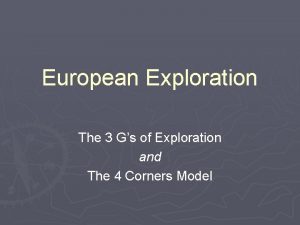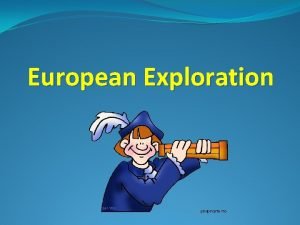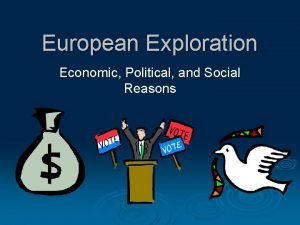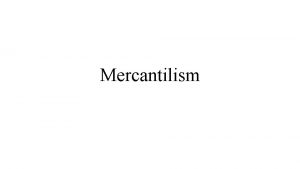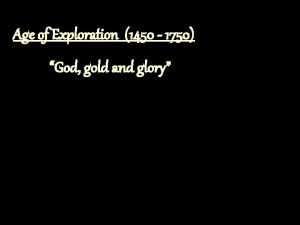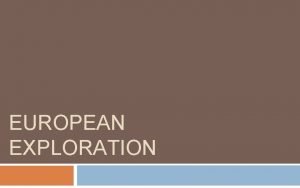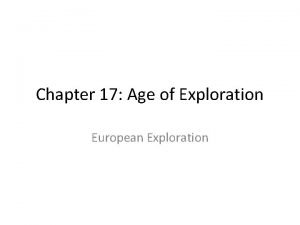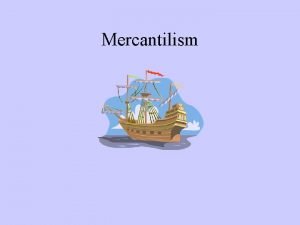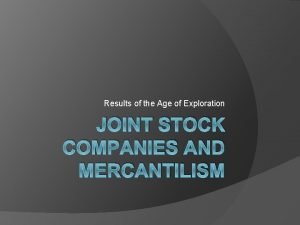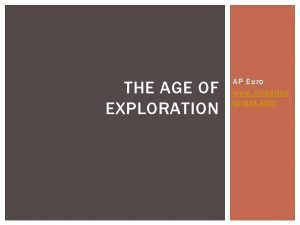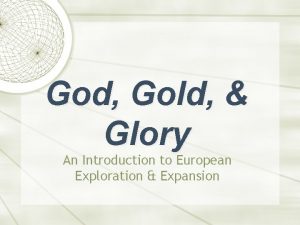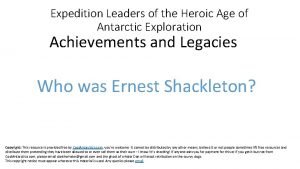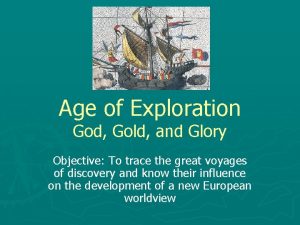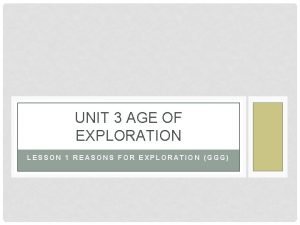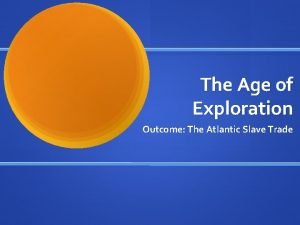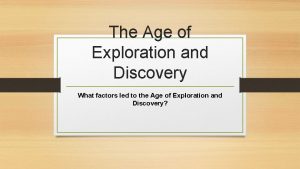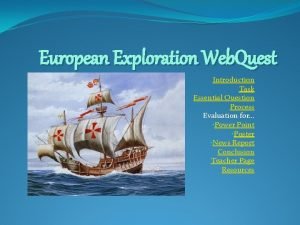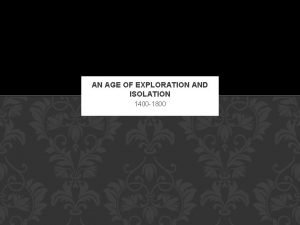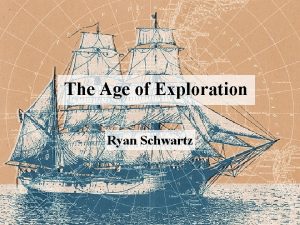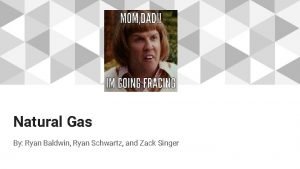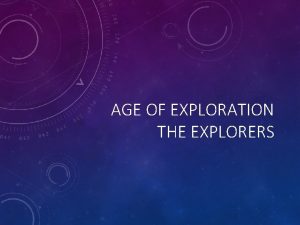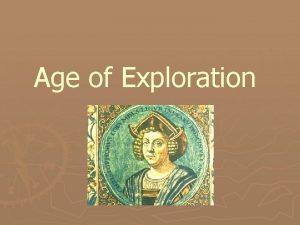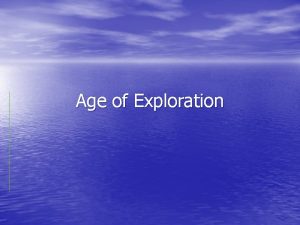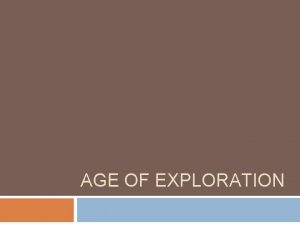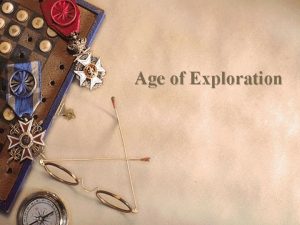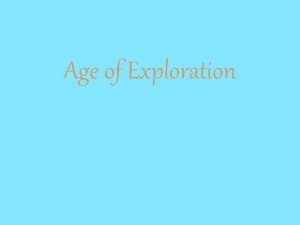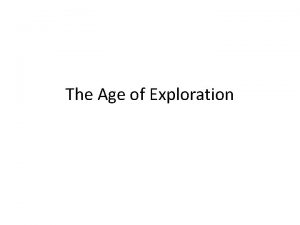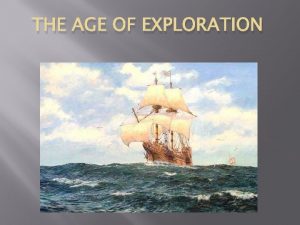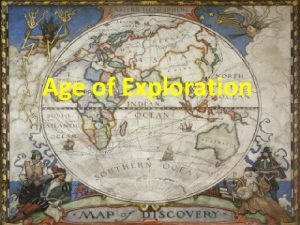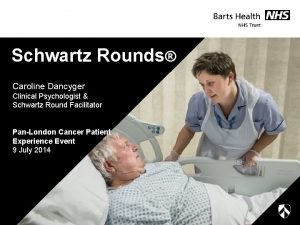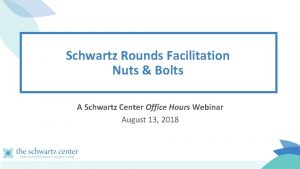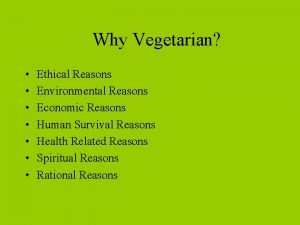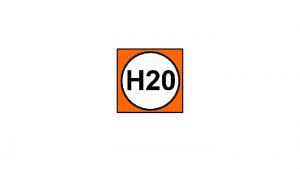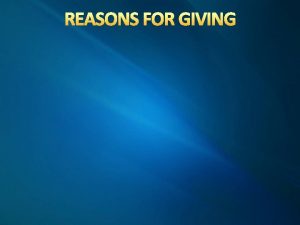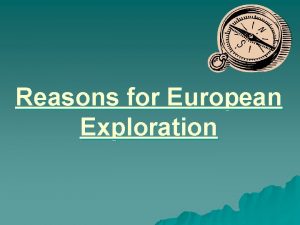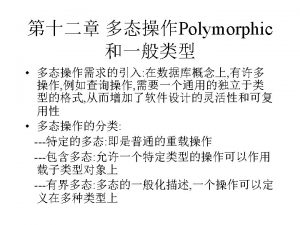The Age of Exploration Ryan Schwartz Reasons for























- Slides: 23

The Age of Exploration Ryan Schwartz

Reasons for Exploration • • The Main Reasons Countries Explored: • Economic- to gain wealth for themselves (bullion) • Political-imperialism • Religious- to spread Christianity, like the Crusades • To gain a trade monopoly in Asia • Myths of treasure • • The purpose of the age of exploration was to find new natural resources for use by Europe’s nations and increase their supplies of wealth (gold and silver). Natural resources were mainly brought back to the home countries from foreign colonies. Another goal of this time period was to spread the Christian faith. Mercantilism was the main policy used during this time and is as follows –the idea that there is a defined amount of wealth in the world and a country should gain as much as they can at the expense of other countries. This can be done by increasing exports and decreasing imports as well as having the government regulating commerce. Nao (exploration vessel) Why Explorers Went: • Wealth- promise of payment from their discoveries as well as myths of foreign wealth • Family- some rights of payment extended to decedents • Titles- given as rewards: could move up a family’s social status • Learn more about foreign lands • • Find natural resources for u at home Procure new sources of gold and silver Spread the Christian faith Bypass the Ottoman Empire’s control on the spice trade from the Orient Spanish Bullion Explorations Financed by: • King or man of high status • Merchants • Investers

Timeline of Explorers Prince Henry “the Navigator” 1394 -1460 (Portuguese) Sponsor of Expedition Ferdinand Magellan 1480 -1521 (Portuguese) - Spain Francisco Pizarro 1474 – 1541 (Spanish) -England (Before 1747) - Great Britain (After 1747) 1300 1250 - Portugal This timeline tells the name and lifetime of each explorer or navigator. The flag attached to their box shows the country that they sailed for. The key shows the country and their corresponding flag. 1400 1350 -Netherlands -France Henry Hudson 1565 -1611 (English) Sir Walter Raleigh 1554 – 1618 (English) Christopher Columbus 1451 -1506 (Genoa) 1500 1450 Bartolemue Dias 1457 -1500 (Portuguese) Vasco de Gama 1460 -1524 (Portuguese) Captain James Cook 1728 – 1779 (English) Samuel de Champlain (1567 -1635) (French) Henry Hudson 1565 -1611 (English) 1600 1550 Vasco Nuñez de Balboa 1475 -1519 (Spanish) Sebastian del Cano 1476 -1526 (Spanish) 1800 1700 1650 Louis Joliet 1645 - 1700 (Canadian) Sir Francis Drake 1545 -1596 (English) Abel Tasman 1603 – 1659 (Dutch) Father Marquette 1637 – 1675 (French) 1750

The Portuguese needed improved agricultural prospects than what they had in their own country, so they set out to foreign places of the world to get what they needed. They also were looking for converts to Christianity as well as to know what was out their. Out of all the countries that participated in the Age of Exploration, the Portuguese were the most secretive and advanced in their methods of navigation, leading the way for the rest of Europe. Portugal only solely dependent on its sea power and imported many luxury items from the Orient such as spices and porcelain. This dramatically increased the wealth of Portugal during this time and made it a major European power on the seas. The list of explores for Portugal are as follows: Portuguese Exploration • • Poor farm land, forced them to import food. Find food source somewhere else. Developed advanced methods of navigation. Became very secretive about their plans and methods. Led the way in early exploration for the rest of Europe to follow First to successfully mount cannons to ships. Arranged ships in squadron for tactical advantage. Exploration dramatically increased Portugal’s wealth. Their success led to competition and fighting for trade routes and ports with other nations. • Explorers are as follows: • Prince Henry the Navigator • Vasco de Gama • Bartholomeu Dias Click HERE for a brief synopsis of Portugal and its explorers.

Prince Henry “the Navigator” His main goal was to reach India and the Orient by going around Africa, but he had difficulty getting sailors to sail around a part of Africa known as Cape Bojador, the place where the Earth is closest to the sun. He never found India. Eventually, he helped establish a system of trading outposts along the African coast that helped future explorers find their way to India. These outposts supplied Portugal with slaves, ivory, and most importantly gold. He was the son of King João I The location of Prince Henry “the Navigator’s” school One of Henry’s trading posts of Portugal and lived from 13941460. He helped Portugal take back its long hold on the Northern African lands from the Moors. He was a mapmaker and wanted to know what was outside the sphere of Europe. In addition, he wanted converts to Christianity and discover the abode of Prester John, a Christian Kingdom that was hidden somewhere in Africa or Asia. Henry also wanted to gain wealth for his nation because most of Europe was running by the mercantilist system and his country needed the most wealth to be the best. • Set up trading posts on the western coast of Africa. • Brought slaves, ivory, and gold to Portugal. (1394 -1460) • Son of King João I of Portugal. • Mapmaker. • Sent explorers to find the Christian kingdom of Prester John and accumulate gold and riches for Portugal. • Overcame superstitions about Cape Bojador by sending Gil Eannes in 1434. • Established a school of navigation in 1418 in Sarges, Portugal. • Responsible for innovations such as the Caravel ship and celestial navigation. Click HERE for a Minute History on Prince Henry and Portugal. Eannes’ Route

Bartolemeu Dias • • • Vasco de Gama was born in 1460 in Vasco de Gama Portugal and became a member of the royal court. He was chosen to go to India with four ships: São Gabriel, Berrio, São Raphael, and a ship for storage. Along with his brother, they ventured down Africa and past the Cape of Good Hope, northeast to India, stopping at Mozambique, Malindi, and meeting many new cultures, which were logged and accounted for, including the Hindus. When they returned to Portugal , the price of spices had dramatically increased thanks to Venice and its monopoly on trade to the Orient. De Gama had carried boatloads of spices (spices, jewels, ivory, and gold) back with him, giving a lot of money to the Portuguese government as well as the stimulating over the spice trade from Venice. ’ R as • This was accomplished easily because Venice was at war with the Ottoman Empire. Pedro Alvares Cabral took control of this assignment, as well as discovering Brazil, while De Gama was sent back to India on another successful mission and became part of King John III of Portugal’s court. De Gama was later sent back to India to be Viceroy and died there in Cochin in 1524 Gam a’s Rou te Di (1457 -1500) • Sent by King João II of Portugal to find a Christian kingdom of Prester John in 1478 -88. Eventually, after Dias’ lifetime, Prester John, the King of Ethiopia, was found. • Discovered the Cabo Tormentosa in 1488, later renamed the Cape of Good Hope. Click HERE for interactive visuals of the tides and currents that made these two explorer’s journeys. Bartolemue Dias was born in Portugal in 1457 into a noble family, and was well educated from an early age. In his later years, he was sent by King João I of Portugal to sail around the southern-most point of Africa and make contact with Prester John, the leader of a Christian kingdom in Africa or Asia which Prince Henry the Navigator desperately wanted to find. On returning back to Portugal, Dias told the King that he had meet Prester John, King of Ethiopia. During this voyage, Dias discovered the Cape of Good Hope, the southern-most point of Africa. He called it the Cabo Tormentosa, or the Cape of Storms, because he sailed around the Cape of Good Hope during a violent storm. The Orient (also known as the Indies) referred to the continents of Africa and Asia from which many exports came into Europe. ou te idea of taking He also accompanied many explorers on voyages to numerous places. He went with Vasco de Gama to India, Pedro Alvares Cabral on the expedition that lead him to Brazil (on the aforementioned page), and Diogo d'Azambuja to explore the Gold Coast of Africa. He died in 1500 in a vicious storm off the Cape of Good Hope. (1460 -1524) • First to circumnavigate Africa and reach the Orient by water in 1498. • Allowed Portugal to take over the spice trade from the Ottoman Empire.

The Treaty of Tordesillas This treaty was put into place in 1494 after the Portuguese and Spaniards had been fighting against one another for their trade routes. This treaty, put in place by the Pope, divided the world into two spheres, three-hundred miles west of the Azores, and everything to the west was Spain’s while everything to the east was Portugal's. This allowed each to keep their current landholdings and avoid deadly confrontations. The treaty was followed for many years but was later ignored by expanding European empires. • • The Pope put this treaty in place in 1494, dividing the world. The western side belonged to Spain and the eastern side to Portugal. • Eventually the Treaty was broken.

Spanish Exploration • • Began looking for Atlantic Route to the east Focused more on new found land Spain gain much of its power in the Wanted to create plantations and exploit mineral and agricultural riches of lands same way the Portuguese did, through exploration. They, however, focused less on Used indigenous people as slave labor trading and more on the new found Americas that lie on the other side of the Atlantic. This Used conquistadors, to establish trade routes and conquer territories all started with Christopher Columbus and his accidental discovery. Conquered and destroyed the Aztec and Incan civilizations The Spaniards conquered the native people with conquistadors in Gained power through exploration search of riches and glory. Some of the conquistadors were Hernando Cortez who Their explorers are as follows: conquered the Aztecs and • Christopher Columbus • Ferdinand Magellan • Vasco Nuñez de Balboa • Sebastian del Cano • Francisco Pizzaro Mayans in Mexico, starting in 1519, while Francisco Pizzaro conquered the Incans in Peru. Many other explorers came from Spain to discover the rest of the world and are listed below:

• Christopher Columbus • • Christopher Columbus was born in 1451 in the Republic of Genoa, Italy and was surrounded by the sea, giving him a desire to discover what was beyond. He was educated late in his life and went to Portugal to fulfill his aspirations and He landed on the island of Hispaniola after receive a charter from the government. He sixty-six days at sea. He thought that he had was rejected. discovered the Orient and was astonished to see such interesting natives. During his voyage, he • He then went to Queen Isabelle I and King also discovered the island of San Salvador Ferdinand V of Castille for a charter but (Walting Island), the island of Santa Maria de la Concepcion (also known as Rum Cay), the was declined again. Then, after the Moors Island of Fernandina (Long Island, Ney York), were defeated at Granada, young nobles the island Isabella (Crooked Island), Cuba, also called Juana (named after Spain’s young called hidalgos expected land in return for Prince), the island of Hispaniola, the island of their services. So, with the help of an Haiti, and the island of San Domingo. During adviser named Santángel, Christopher the last part of this voyage, the ship Santa María sunk. Columbus’ mission, now to gain new land Columbus had three other voyages, which abroad for the numerous hidalgos, was involved converting the locals to Christianity approved in 1492. across the Atlantic that resulted in the discovery of the islands of Montserrat, San Martin, Santa • Columbus thought he could also find a Cruz , Antigua, and the Virgin Islands, and San new route to India on his voyage by going Juan Bautista (Puerto Rico). During these voyages, Columbus started the west of the Canary Islands. As he set out Spanish tradition of abusing and interacting on his journey, he was given a fleet of with the inhabitants of their colonies. Columbus died in 1506. three ships consisting of the Niña (also called the Santa Clara), the Pinta, and the Santa María. Diagram of Columbus’ Voyages (1451 -1506) • Born and raised in Genoa. • Explorer for Spain after being rejected by Portugal. • Sent in 1492 to discover a westward passage to the Orient. • He sailed a total of four voyages (see map). • Founded colonies, bringing great wealth to Spain. • Established tradition of mistreating the native people. Click below for a documentary on Columbus. Part 1 Part 2 Part 3 Part 4 Part 5 Part 6 Part 7 Part 8 Part 9 Part 10 Columbus Discovers Jamaica

Ferdinand Magellan • • During this journey, starting in 1519, Magellan traveled down the eastern coast of South America and reached a strait near the very bottom, passed through it, and named it after himself, the Strait of Magellan. He also named • Ferdinand Magellan, born in 1480 in northern Portugal, was the ocean that lied beyond it which Captain Balboa found, the Pacific Ocean. raised around the talk of fabulous explorers and amazing It was named this because of its calm waters. Mutinies occurred during this discoveries, making him want to see the world. He did this time as well a scurvy, killing many crew member onboard. Later, they by fighting in the battle of Malacca and Morocco for the Portuguese and sailing with them on a journey to conquer reached Guam, Moluccas, and the Philippines where Magellan died in 1521 Melaka and seek the Spice Islands. from a war between his crew and the natives, ending up with a poison arrow • After being kicked out of Portugal, he joined a monastery in his foot and a spear through his heart. and began to study the arts of exploration: charts, pilots’ Sebastian del Cano, a member of the crew left after Magellan died, finished logs, and maps. He later presented an idea of finding a route to the Indies through the New World to King Charles I of the journey and returned to Spain, going through the Indian Ocean, around the Spain, who enthusiastically agreed. He was given five ships Cape of Good Hope, and up the western side of Africa. In Spain, he is called the Santiago, the Conception, the San Antonio, the remembered as the first man to circumnavigate the globe while in the rest of Victoria, and the Trinidad. He would also be given the title the world, since many of the European countries hated Spain, like England, of governor to any new lands that he found on his way. said that Magellan was the first man to circumnavigate the globe. • globe. Their Route Sebastian del Cano (1480 -1521) • He was a Portuguese man expelled from Portugal • Knowledgeable in the art of navigation • Hired by Spain in 1519. • Charles I of Spain sent him to find a passage to the Orient through the new world. • Found and navigated the Strait of Magellan. • Killed in the Philippines by a poison arrow to the heart in 1521. • Sebastian del Cano, a member of the crew, took command of the ship and sailed it back to Spain in 1522. • He was the first man to circumnavigate the globe. • England hated the Spanish, naming Magellan the first to circumnavigate the globe instead of Del Cano. Click HERE for a detailed animation on the voyage of these two explorers. (1476 -1526)

Vasco Nuñez de Balboa Discovers the Pacific The Pacific Ocean was named the South Sea by Balboa, and the Pacific Ocean by Magellan. (1475 -1519) • Explorer and conquistador. • Founded a colony in South America called Santa María de la Antigua del Darién after wandering in the Caribbean for ten years in 1511. • Discovered the Pacific Ocean in 1513 by crossing the Isthmus of Panama.

Francisco Pizzaro Click HERE for the first part of a background on Pizarro’s conquering of the Incan Empire. Click HERE for part two. (1474 -1541) • He was a Spanish conquistador that conquered the Incan Empire in Peru and Chile in 1532. • Helped Balboa discover the Pacific Ocean. • Pizarro was financially helped by the Holy Roman Emperor Charles V (Carlos I of Spain). • Both were attracted by the gold and riches the land held. A Francisco Pizzaro, born in 1475 to an army conquistador is a officer, was a shipmate with Captain Balboa as he discovered the Pacific Ocean after conqueror of the native crossing the Isthmus of Panama. He stayed in Panama until the allure of riches in South civilizations of Mexico and America tempted him to go there. • He tried and failed two times then, with the Peru. help of Charles V, Holy Roman Emperor, he • • set sail, once again, to conquer. Pizzaro marched to the Incan city of Tumbes, which was in rubbles from a recent war, and was easily taken over. In a short time, all of Peru was under his grasp and he moved towards Chile and its gold. His ally, Diego Almargo, conquered the city of Cuzco, the Incan capital, and enraged Pizzaro in the process. Pizzaro had Almargo executed and was then killed by Almargo’s son for revenge in 1541. Pizzaro’s Expeditions Pizzaro and the Incan Emperor

English Exploration • The largest empire in Europe and they wanted to keep expanding. • American colonies provided natural resources. • Triangular slave trade between the American colonies, Europe, and Africa. England had a vast array of colonies from the Pacific to Atlantic, making it the largest Empire in the world. England’s largest and most prominent colonies were the American colonies and Australia. The American colonies were used for their natural resources and ability to produce large amounts of food. England has a long history of banishing religious groups, such as the Mormons and the Amish. It also largely participated in the triangular slave trade. This involves competed products exported from Europe and being shipped to Africa. It is exchanged their for slaves who are shipped of to the American colonies who exchange them for raw materials which get shipped off to Europe. Then the cycle starts again. This was a part of the Columbian Exchange, in which Europe and the New World exchanged not only goods and customs but diseases as well. Australia was a prison island that was used to banish prisoners out of the overflowing jails. This was its only real purpose and Australia did not supply England with many resources. There are many explorers who discovered new lands, allowing England later Great Britain to grow to its enormous size. Some of the explorers are listed below: • Australia used as a prison colony for the jail overflow. • Widespread exchange of animals, plants, culture, human population, and diseases influenced ways of life (Columbian Exchange). • Their explorers are as follows: • Sir Francis Drake • Henry Hudson • Sir Walter Raleigh • Captain James Cook

Sir Francis Drake helped defeat the Spanish Armada, a fleet of 170 Spanish ships sent in 1588 against England in response to it’s interference in Spain’s slave trade. The Armada was defeated by a combination of the English and a violent storm, thus opening the Americas to other countries. Sir Francis Drake • • Click HERE to watch an amazing student-made biography on Sir Francis Drake’s Circumnavigation Sir Francis Drake, born in 1545 in England, was the first Englishman and second European to circumnavigate the globe. He took a different route than Magellan and del Cano because he went all the way up the west coast of North America to California or Vancouver and founded the colony of Nova Albion for Queen Elizabeth I. Its location was a secret so no one know how far Drake actually went up the west coast. After that, he sailed across the Pacific, back through the Indian Ocean, and up Africa to Europe. During this endeavor, Drake pirated Spanish ships near Panama and landed on the island of Cano near Mexico. Later in his life, Drake fought against and defeated the Spanish Armada in 1588 when he was second in command. The dispute was over the slave-trade which was very profitable for the Spanish. He was such an excellent fighter at sea that the Spanish called him “El Draque”, which means The Dragon. He died shortly after in 1596. (1545 -1596) • The first Englishman and the second European to circumnavigate the globe in 1577 -80 • Privateer • His route took him up the west coast of North America, where he established the colony of Nova Albion • He fought the Spanish Armada in 1588

Henry Hudson • • • (1564 -1611) • An Englishman who tried four times, in 1608, 1609, and 1610, to find a northern passage to the Orient • Explored many parts of Greenland Canada when sailing for the English in 1607 and 1608 • He later sailed for the Dutch East India Company in 1609 and 1610 and explored a large portion of the Hudson Bay and its many connecting waterways Sir Walter Raleigh was born in 1554 in • Born in 1565 in England, Henry Hudson was Hayes Barton in Devon. He trying to find a northern passage to the Orient. was a favorite of Queen Elizabeth I and was the man who sponsored the first two attempts He tried four times, and failed. His first try was in colonizing North America at Roanoke. with the Muscovy Company in 1607 which, as The first of the two colonies was expected, failed due to icy conditions, but he unsuccessful and the second one was managed to explore some of Greenland also mysteriously disappeared. discovered new whale hunting territory. His failures were slightly diminished by the discovery of the potato which he brought • On his second voyage in 1608, Hudson tried back with him to Ireland. This discovery again and failed to discover the Northeastern greatly helped the Irish economy. Passage. He went as far as Novaya Zemlya, an He later searched for El Dorado but was archipelago north or Russia, before he had to executed in 1618 when he conflicted with the Spanish after James I became King. turn back. • Hudson later joined the Dutch East India Company and in 1609 tried to discover the Northeastern Passage for a third time. He was, again, blocked by ice in Russia but backtracked and ended up in Nova Scotia. • On his last and final journey 1610, Hudson left from England went to the southern-most tip of Greenland, entering a waterway later called the Hudson Strait. He then found the Hudson Bay and James Bay but came to a dead end. His crew was so mad at Hudson that they cast him adrift in the ocean, along with his son and some crew members, to die. This act of mutiny occurred in 1611. • An Englishman and a favorite of Queen Elizabeth I who sent him to colonize North America at Roanoke in 1585 and 1587, both failed • Brought the potato to England from North America Henry Hudson’s Voyages The Colony of Roanoke Sir Walter Raleigh (1554 -1618)

Captain James Cook • • • Captain James Cook, born in 1728 in Martonin-Cleveland, England, joined the Royal Navy His third and final His second voyage lead him through the Antarctic Circle. journey was in search of This allowed him to theorize the existence of Antarctica. a northwestern passage Cook also discovered the islands of Tonga, New Hebrides, Easter Island, and the Cook Islands. in which he discovered the Sandwich Islands His third and final journey was in search of a northwestern (Hawaiian Islands). passage in which he discovered the Sandwich Islands Cook noticed that all of (Hawaiian Islands). Cook noticed that all of the different Polynesian islands had many cultural and lingual islands had many characteristics that were similar. He then went to the cultural and lingual western coast of North America looking for the northwest characteristics that were passage but returned to the Sandwich Islands for repairs. similar. He then went to There, Cook was killed by the once friendly natives in 1779. the western coast of North America looking for the northwest passage but returned to the Sandwich Islands for repairs. There, Cook was killed by the once friendly natives in 1779. Cook’s Voyages • • (1728 -1779) Member of the Royal Navy and the Royal Society of London, who gave him the task of studying Venus at sea in 1768. During initial voyage found cure for scurvy by eating fruits and vegetables. Circumnavigated islands of New Zealand the strait that divided them (the Cook Strait). Finished expedition by sailing around the Cape of Good Hope, circumnavigating the globe. (1768 -1771) • • • Second voyage led him into the (1772 -1775) Antarctic Circle in 1772. This allowed him to theorize the (1776 -1779) existence of Antarctica. Found Tonga, New Hebrides, Easter Island, and the Cook Islands. Discovered Sandwich Islands (Hawaiian Islands) on his final voyage in 1776. Made the connection between the different Polynesian Languages and cultures. Killed by the native Hawaiians in 1779. Cook’s Death

Dutch Exploration • • • In 1600, the Dutch had more ships than any other nation. Encouraged privateers to prey on poorly defended Spanish and Portuguese ships. In 1602, the Dutch East India Company was created and found a route to Asia, occupying unclaimed lands. Pushed French and English out of Indonesia. In 1614, the New Netherlands Company created to occupy lands in North America between New France and English Virginia. In 1621, Dutch West India Company began trading with West Africa and the Western Hemisphere. Began settling in Delaware, Connecticut, and along the Hudson River. In 1634, the Dutch seized the Spanish possessions in the West Indies (the Caribbean). One of their explorers is listed below: • Able Tasman • Henry Hudson (shown under England)

Dutch Abel Tasman • • Abel Tasman was born in Lutjegast, Gröningen in 1603 and became part of the Dutch East India Company in his late twenties. He quickly rose up in the ranks. He was then assigned to explore the mass continent Terra Australis Incognita, or the Great South Land, and find routes for trade with China and Chile. During this voyage, in 1642, Tasman discovered the southern Australian island of Van Diemen’s Land (Tasmania), which he claimed for the Dutch East India Company, New Zealand, where he was attacked by native Maori islanders and mistook it for South America, the small island of Tonga, and the first European to see the Fiji Islands. This mission was considered a failure because no new trade connections were established. On his second journey, in 1643, Tasman was assigned to discover if New Guinea was part of Great South Land. When he ventured out to uncover the truth, he completely missed the Torres Strait that splits the two and called them one giant land mass. He died in Batavia in 1659. Tasman's Expeditions • 1642 1643 • Tasmania • • (1603 -1659) Worked for the Dutch East India Company. Sent to explore the mass continent of Terra Australis Incongnita and establish trade relations with China and Chile in 1642. Discovered the islands of Tasmania, New Zealand (and its violent Maori inhabitants), Tonga, and Fiji in 1642 He did not establish any trade connections. Second voyage in 1643 to see if New Guinea and Terra Australis Incongnita were connected. Missed the Torres Strait that divided them and said they were one.

French Exploration • They wanted to increase the size of their empire, making it even larger than England’s. • As a highly religious country, one of their goals was to spread Christianity. • They wanted spices and riches, like the ones from the orient, but looked for them in the west instead of the east. • Fur was very popular in France and in high demand. They looked for new sources of fur. • Their explorers are as follows: • Father Marquette • Louis Joliet • Samuel de Champlain

Father & Louis Joliet Marquette (1645 - 1700) (1637 – 1675) French (Marquette) and Canadian (Joliet) explorers. • Father Marquette was a Jesuit priest. • They discovered the Mississippi River in 1673, hoping to find a river connecting the Pacific and Atlantic Oceans. • Father Marquette also made it his goal to convert the native indians to Christianity. • Marquette started a colony in Illinois that later became Chicago in 1674. Samuel de Champlain Marquette and Joliet Exploring the Mississippi (1567 -1635) • • French explorer. Sailed and Recorded most of Nova Scotia in 1604 -07. Established a fur trading center in Quebec in 1608. Explored the Great Lakes and Discovered Lake Champlain in 1609. Marquette, Joliet, and Champlain’s Routes

Ships of the Age Caravel One ship of this time period was called a caravel, which had a firm rudder for good control and was slim for nimbleness. The boat itself is shallow so that it can sail around coastal waters without running aground. It could be controlled with twenty-five men and could interchange its triangular sails for square sails, allowing it to maneuver better in storms and have good speed in between winds. This version was called the caravela redonda, the ship that the Portuguese bragged about having in their fleet. • Invented by Prince Henry “the Navigator” at his navigation school and a favorite among the Portuguese • Strong rudder for good maneuverability • Shallow hull (six foot depth) for sailing coastal waters • Operated by a small crew (25 men) • Could interchange square sails for triangular ones, allowing greater mobility in storms • Fastest of its time Nao • Square sails allowed for faster speed with little wind • Larger hull allowed for more storage and longer journeys • Deeper hull gave greater stability to the boat in the open ocean • Three large masts gave the ship better control of the wind in storms • Magellan's fleet was comprised of these ships The next ship of the age was called a nao. This specific ship has square sails, allowing for better maneuverability in storms and faster speeds when no winds are present. It is a larger ship so that it can carry more supplies for longer journeys and has a deeper hull for greater stability in the open ocean. Its also has three masts for better wind control in hectic storms. This ships was very popular during the age of exploration. All of Magellan’s fleet was comprised of naos ships.

Inventions Advancements in the field of navigation helped explorers find their way. • • • Compass Only instruments that pointed in a northward direction, not exact locations for navigators. Old compasses were made out of a magnetized iron needle. They later evolved into a painted disk with directional arrows with a rotating brass pin. • • • Astrolabe Measured latitude while sailing, determines your position north or south of the equator. Measured the angle between the horizon and a celestial body, like he North Star. Go to a chart called a ephemeris and find the parallel that corresponds with the specific celestial body on a specific day. Calculating Longitude It involved determining the speed of the ship, compass direction, and time of day. Speed was measured by how fast a piece of wood would float to the end of the ship from the bow. Time was taken with using sundials and hour glasses. Astrolabe Hourglass

Works Cited Allen, Oliver E. The Pacific Navigators. Alexandria, VA: Time-Life, 1980. Print. "Bartholomue Dias. " Elizabethan Era. N. p. , n. d. Web. 15 Dec. 2012. "Bartolomeu Dias. " Infoplease, n. d. Web. 8 Jan. 2013. Buzzitta, Pat. "Marquette, Father. " Learning to Give. Points of Light Institute, n. d. Web. 10 Jan. 2013. "Christopher Columbus. " Christopher Columbus. Soylent Communications, n. d. Web. 16 Dec. 2012. "Explorers. " Enchanted. Learning. com. N. p. , n. d. Web. 9 Jan. 2013. Farrington, Karen. Historical Atlas of Expeditions. New York: Checkmark, 2000. Print. "Henry Hudson Biography. " Bio. com. A&E Networks Television, n. d. Web. 15 Dec. 2012. Humble, Richard. The Explorers. Alexandria, VA: Time-Life, 1978. Print. "Juan Sebastian Del Cano (Spanish Navigator). " Encyclopedia Britannica Online. Encyclopedia Britannica, n. d. Web. 15 Dec. 2012. "Louis Joliet. " Elizabethan Era. N. p. , n. d. Web. 8 Jan. 2013. "Magellan. " Think. Quest. Oracle Foundation, n. d. Web. 16 Dec. 2012. "Prince Henry the Navigator. " Enchanted. Learning. com. N. p. , n. d. Web. 7 Jan. 2013. "Prince Henry the Navigator's Life. " Timeline. N. p. , n. d. Web. 15 Dec. 2012. "Samuel De Champlain: Explorer. " Enchanted. Learning. com. N. p. , n. d. Web. 9 Jan. 2013. "Sir Francis Drake: Explorer. " Enchanted. Learning. com. N. p. , n. d. Web. 16 Dec. 2012. "The French Come to the New World. " Explorers. N. p. , n. d. Web. 10 Jan. 2013. "Vasco Da Gama. " Think. Quest. Oracle Foundation, n. d. Web. 16 Dec. 2012. Mejiak, Michelle. "Vasco Da Gama Arrives in India. " World History Cronology. Ed. Dana Thompson. N. p. , 15 Dec. 1998. Web. 8 Jan. 2013.
 3 gs of exploration
3 gs of exploration What are the 5 reasons for exploration
What are the 5 reasons for exploration God gold and glory pictures
God gold and glory pictures European exploration economic reasons
European exploration economic reasons Iron age bronze age stone age timeline
Iron age bronze age stone age timeline Iron age bronze age stone age timeline
Iron age bronze age stone age timeline Mercantilism
Mercantilism Age of exploration videos
Age of exploration videos Age of exploration gold
Age of exploration gold Why was gold a motivation for exploration
Why was gold a motivation for exploration Age of exploration motives
Age of exploration motives Mercantilism during the age of exploration
Mercantilism during the age of exploration Joint-stock companies during the age of exploration
Joint-stock companies during the age of exploration Age of exploration ap euro
Age of exploration ap euro Explain god gold and glory
Explain god gold and glory Heroic age of antarctic exploration
Heroic age of antarctic exploration Age of exploration saq
Age of exploration saq Alonso alvarez de pineda route
Alonso alvarez de pineda route God gold and glory
God gold and glory Ggg
Ggg The age of exploration outcome the atlantic slave trade
The age of exploration outcome the atlantic slave trade What factors led to the age of exploration
What factors led to the age of exploration European exploration webquest
European exploration webquest Dutch exploration routes
Dutch exploration routes
